215 vs 235 tires: Which Is Better?
Mounting wrong sized tire on your car can affect its performance, comfort, and safety. Make sure to mount the right tires to unlock the full potential of your car while also not compromising on integrity and safety.
215 vs 235 tires? Which is better? A 215 tire is narrower compared to a 235 tire. If you prioritise fuel efficiency and manoeuvrability, opt for 215 tires, whereas if stability, traction, and high loading capacity are important, go for 235 tires.
This article provides all information you need to have about 215 vs 235 tires. Each tire offers distinct advantages and potential drawbacks. Let’s dive into this guide to gain a complete understanding of the 215 vs 235 tire debate and choose the right option for our specific needs.
What Do 215 And 235 Tires Mean?
The tire width of your tires is indicated by the numbers 215 and 235. The 235 has a width of 235 mm and the 215 has 215mm. The width is measured from one sidewall to the opposite sidewall of the tire. (Sidewalls are nothing but the actual sides of the tire, if you notice, the width will be mentioned there).
There are a few numbers on the sidewalls of the tire. It is essential to know since those are the main indicators. For example, “215/60R15”, “215” is the width, which is simply 215mm. “60” is the aspect ratio, “R” denotes the tire type as Radial, and “15” is the diameter.
| Feature | 215 Tires | 235 Tires |
|---|---|---|
| Feature | 215 | 235 |
| Tire Width | 215 mm | 235 mm |
| Wheel Diameter | 17 inches | 17 inches |
| Circumference | 2234.61 mm | 2316.3 mm |
| (Aspect Ratio) | 118.25 mm | 129.25 mm |
| Revolutions | 447.5 km | 431.72 km |
| Weight | Lighter | Heavier |
215 vs 235 Tires: What Are The Differences?
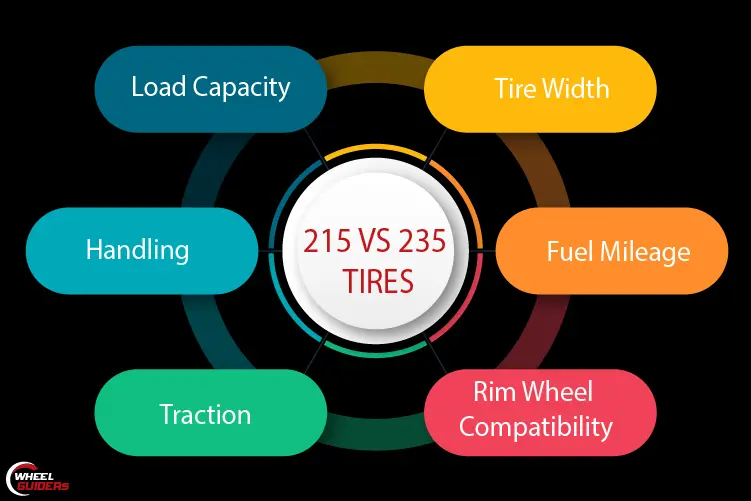
215 vs 235 Tires: Tire Width
The tire width of a 215 tire is 215 mm. The tire width of a 235 is 235 mm. Although there are a lot of differences than just the number itself. We will now be going through the major differences one by one.
215 vs 235 Tires: Fuel Mileage
Since 215 tires are narrower, it has a lower amount of friction. This means that the amount of force required for the tire to move is less, which directly results in lower rolling resistance. You guessed it right, tire 215 consumes less fuel than Tire 235.
Why does the tire 235 consume more fuel? Because the 235 tire is slightly wider and even the contact path of the 235 tire is wider. This means that the rolling resistance is higher, resulting in consuming a larger amount of fuel.
215 vs 235 Tires: Rim Wheel Compatibility
The rim is the outer edge of the wheel. It is the meeting point of the metal and the tire. The ideal rim width of a 215 tire can be between 7.0 inches and 7.5 inches. Whereas the ideal rim width of a 235 tire can be between 8.0 inches and 8.5 inches. In terms of compatibility, 235 tires offer a slightly wider range of rim widths compared to 215 tires
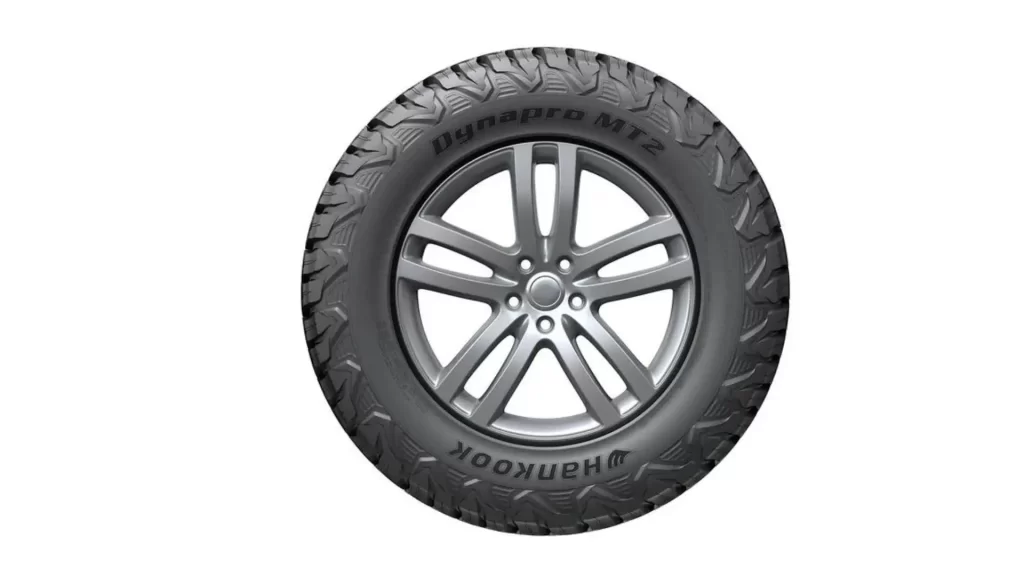
215 vs 235 Tires: Traction
Majority of the car companies prefer wider tires as it allows better traction and durability. A 235 will outperform a 215 easily on dry surfaces. The higher tire contact area is the reason behind this phenomenon.
The improved contact area between the road surface and the tire will distribute the weight efficiently which will improve the traction. A higher tire contact ultimately results in better weight distribution. Improved weight distribution enhances traction performance.
215 vs 235 Tires: Handling
A 235 tire is better than a 215. The 215 tire provides less grip and moderate handling compared to the 235 tires. The basic science behind this is that 235’s wider tread blocks provide a much better level of handling especially during cornering.
Wider tread blocks also improve the stability and control while reducing deformation which improves the overall handling.
215 vs 235 Tires: Load Capacity
Load capacity holds the utmost importance for every vehicle owner. The load capacity of a tire is typically indicated on the sidewall. 235 tires generally exhibit a higher load-carrying capacity compared to 215 tires.
This means that 235 tires are designed to handle heavier loads, making them a suitable choice for vehicles that require increased load-carrying capabilities.
| Feature | 215 Tires | 235 Tires |
|---|---|---|
| Width | 215 mm | 235 mm |
| Grip | Not as good as 235 tires | Better than 215 tires |
| Handling | Not as good as 235 tires | Better than 215 tires |
| Fuel Efficiency | Better | Average |
| Price | Cheaper | Expensive |
| Comfort | Better | Average |
| Appearance | Less aggressive | More aggressive |
What Are The Advantages Of 215 Tires?
Wider tires have so far scored more points than narrow ones. In dry conditions 235 tires are better, but in the rainy or winter season, narrower tires such as the 215 offer more grip.
Enhanced Fuel Economy
The narrower width of the 215 tires helps it in reducing the rolling resistance which in turn decreases the energy required by the tire to propel the vehicle forward.
As fuel price keeps increasing, our pockets keep emptying. If your priority for your car is to be fuel efficient, then 215 tires are proven to consume a lesser amount of gas and the extra bonus is that it is eco-friendly.
Superior Comfort
It is a general rule that large-sized wheels usually result in a rougher ride. A 215 wheel provides superior comfort when compared to other bigger tires. The narrow tire has a bigger sidewall aspect ratio. Therefore, the sidewall is more substantial than the ones found in wider tires which results in a much more comfortable ride.
Cost Effective Solution
215 tires are a cost-effective solution due to their lower initial purchase cost compared to wider options. They also offer improved fuel efficiency which reduces the long-term fuel expenses.
Moreover, their design promotes extended tire life, minimizing the frequency of tire replacements and saving money. The availability of 215 tires in the market and competitive pricing options further contribute to their cost-effectiveness.
Reduced Road Noise
215 tires are known for their ability to reduce road noise. This is because the narrower width of these tires helps to minimize the contact area with the road surface. When there is less contact between the tire and the road, there is less friction, which leads to reduced vibrations and noise generation.
The optimized tread pattern and design of 215 tires also contribute to noise reduction. The tread pattern is designed to channel and disperse sound waves, which helps to reduce the amount of noise that is transmitted into the cabin of the vehicle.
Improved Performance In Heavy Snow Or Standing Water
215 tires are much better in heavy snow or rain, basically on wet surfaces. Because the width of a 215 is narrow, it has the capacity to dig into snow or cut through standing water. A 215 tire exerts more pressure per square inch, hence the capacity to outperform wider tires.
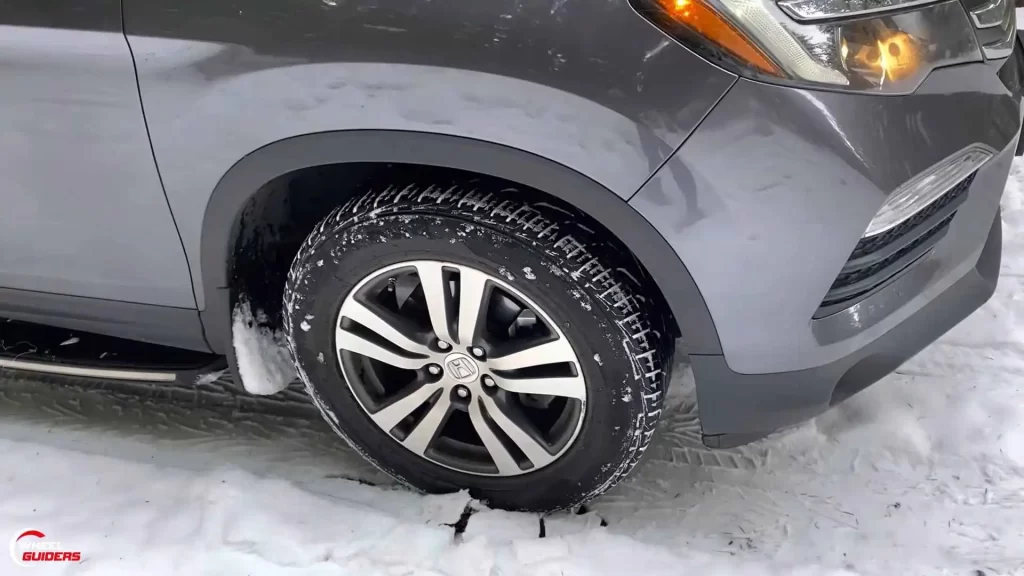
The narrow profile of a 215 tire also helps to improve maneuverability in wet conditions. This is because the tires are less likely to hydroplane, which is when a tire loses contact with the road surface due to a layer of water between the tire and the road.
What Are The Advantages Of 235 Tires?
While 235 tires are a touch more expensive than its narrower friends, it has its own share of advantages to flex.
Improved Handling Performance
Who doesn’t like better handling performance? 235 tires have more evenly distributed weight. 235 tires offer improved handling performance because they have a wider construction. The wider construction creates a larger contact patch with the road surface.
The wider tread width improves lateral stability which minimizes sidewall flex and promotes better control and responsiveness. Moreover, the wider design of 235 tires enhances steering precision and feedback while providing drivers with a heightened sense of road connectivity
Enhanced Dry Traction
Wider tires have a wider contact patch. This means it will be able to stay in touch with the roads much easier than the narrow tires. Better weight distribution equals better traction. Therefore, 235 tires do have enhanced dry traction.

Aesthetic Appearance
235 tires enhance the aesthetic appearance of vehicles with their wider profile, filling the wheel wells more effectively. The broader sidewalls and tread create a bold and aggressive stance which adds a touch of sportiness. When the 23 tires are paired with larger rims, they create a visually striking combination.
Better Cornering Stability
The Cornering Stability is a control that kicks in when the car takes on a sharp corner. Instead of oversteering, this control protects you and keeps your car straight. The cornering stability is better with 235 tires because of its wider width.
Increased Load Capacity
235 tires lift and carry a larger capacity than narrower tires because it stays in touch with the road. It offers less pressure and more stability.
Are 215 And 235 Tires Interchangeable?
Yes, 215 tires and 235 tires can be interchanged. Although this does depend on the tire aspect ratio and rim diameter. If both sets of tires possess identical specifications, it is possible to interchange them. If not, invest in new tries.
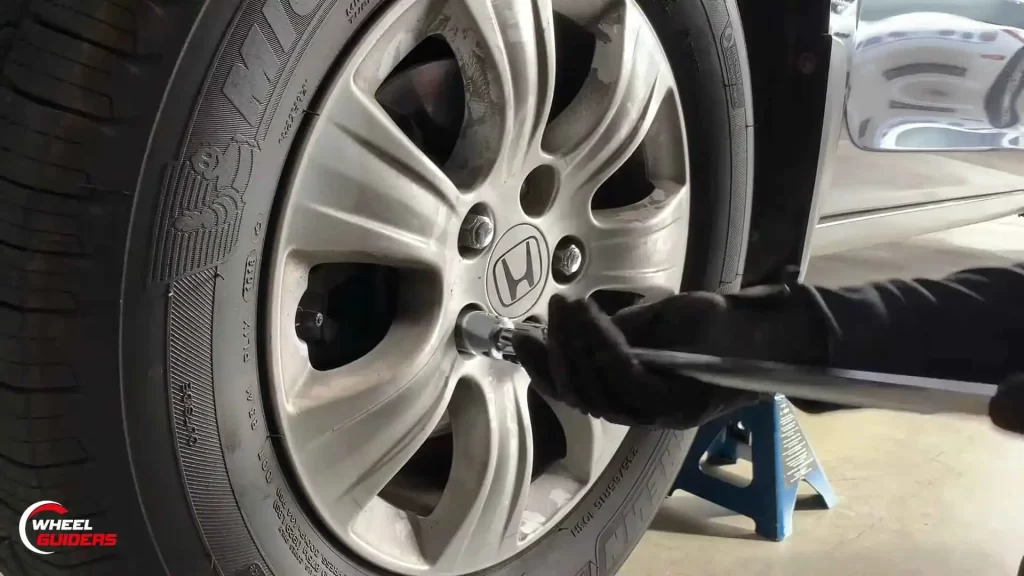
Can I Use 215 Tires Instead of 235?
Yes, You can use 215 tires instead of 235 tires, keeping in mind that 235 tires are 20 millimeters wider than 215 tires which would reduce the grip and handling capabilities of your vehicle with the narrower option.
Can 235 Tires Replace 215?
Yes, 235 tires are 20mm wider than 215 tires. If the tire aspect ratio and rim diameter remain the same or compatible, 235 tires can serve as replacements for 215 tires.
How much bigger are a 235 and a 215 tire?
The 235 tires are 20 mm wider when compared to the 215 tires. There is a 9.3% size difference. The 235s offer better handling and grip due to the increased size.
Staggered Vs Squared Tire Setup
A staggered tire involves using narrower tires in the front and wider tires in the rear, while a squared tire setup involves using the same tire size on all four tires. Staggered setups are commonly found in high-performance vehicles to optimise traction and handling characteristics. On the other hand, squared setups are often used in all-wheel drive (AWD) vehicles to make sure equal power is distributed to all four tires.
In a staggered tire setup, the narrower tires on the front axle provide better steering response and handling as narrower tires have smaller contact patches with the road making it easier to turn whereas the wider tires on the rear axle provide more traction and stability due to larger contact patch.
In a squared tire setup, using the same tire size on all four wheels provides consistent handling and steering response. With equal tire sizes, the contact patch remains consistent across all tires, promoting balanced traction and stability.
How To Make Room For Wider Tires?
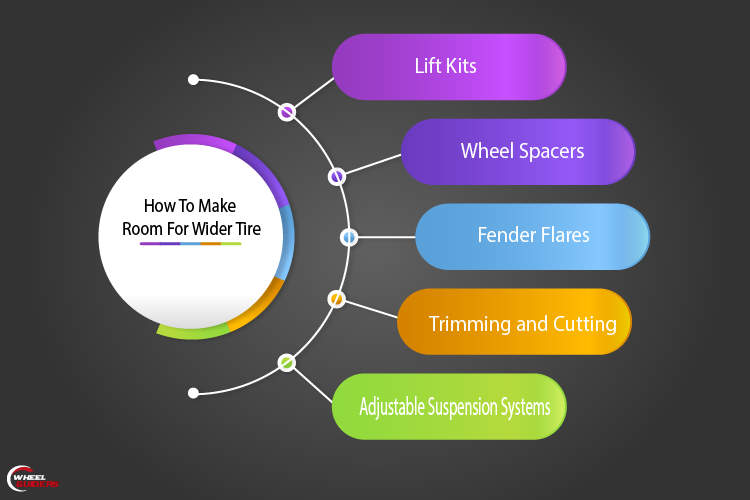
To make room for 235 tires on a vehicle originally fitted with 215 tires, you can consider one of the following options.
Lift Kits
Installing a lift kit raises the vehicle’s suspension, providing more space between the tires and the body
Wheel Spacers
Wheel spacers are utilised to create an increased gap or distance between the wheel and the hub assembly. This widens the track width of the vehicle and creates additional space for larger tires
Fender Flares
Fender flares are aftermarket accessories that can be added to the wheel arches of a vehicle. They extend the width of the fenders, providing more clearance for larger tires
Trimming and Cutting
In some cases, you may need to trim or cut parts of the vehicle’s body or inner fender liners to create room for larger tires.
Adjustable Suspension Systems
Some vehicles come equipped with adjustable suspension systems that allow you to raise or lower the ride height. By increasing the suspension height, you can create space for larger tires
Bottom Line
The type of tire you want is entirely subjective. The tires of a car can be everything. When you have a clear understanding of your priorities, selecting the appropriate tires becomes a relatively simpler task.
Understanding the differences between 275 vs 285 tires is also important as it can provide insights into wider tire options suitable for specific vehicle needs.
A 235 tire provides a better loading capacity, better traction in dry areas, makes your car look sexier, and let’s not miss the better handling.
On the other hand, 215 tires do not cost a lot and are fuel efficient. If you live in wet areas, 215s are a better option. Consider all relevant factors and then select tires that align better with your specific requirements.
